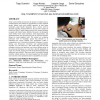Free Online Productivity Tools
i2Speak
i2Symbol
i2OCR
iTex2Img
iWeb2Print
iWeb2Shot
i2Type
iPdf2Split
iPdf2Merge
i2Bopomofo
i2Arabic
i2Style
i2Image
i2PDF
iLatex2Rtf
Sci2ools
ASSETS
2010
ACM
2010
ACM
Towards accessible touch interfaces
Touch screen mobile devices bear the promise of endless leisure, communication, and productivity opportunities to motor-impaired people. Indeed, users with residual capacities in their upper extremities could benefit immensely from a device with no demands regarding strength. However, the precision required to effectively select a target without physical cues creates problems to people with limited motor abilities. Our goal is to thoroughly study mobile touch screen interfaces, their characteristics and parameterizations, thus providing the tools for informed interface design for motor-impaired users. We present an evaluation performed with 15 tetraplegic people that allowed us to understand the factors limiting user performance within a comprehensive set of interaction techniques (Tapping, Crossing, Exiting and Directional Gesturing) and parameterizations (Position, Size and Direction). Our results show that for each technique, accuracy and precision vary across different areas of th...
| Added | 10 Feb 2011 |
| Updated | 10 Feb 2011 |
| Type | Journal |
| Year | 2010 |
| Where | ASSETS |
| Authors | Tiago João Guerreiro, Hugo Nicolau, Joaquim A. Jorge, Daniel Gonçalves |
Comments (0)

